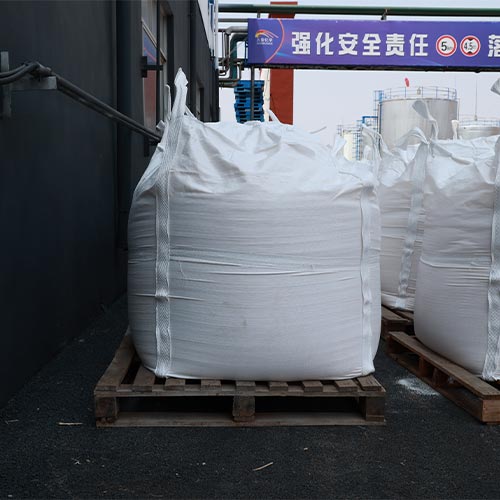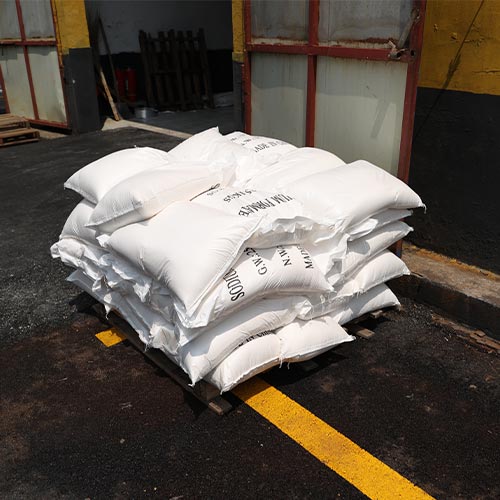مقدمة ل فورمات الصوديوم

فورمات الصوديوم مركب كيميائي مشتق من حمض الفورميك. يظهر كمسحوق بلوري أبيض ويحمل أهمية كبيرة في مختلف الصناعات بسبب خصائصه الفريدة. هذا المركب، المُمثل كيميائيًا باسم NaCHO2، يعمل كمادة متعددة الاستخدامات ولها تطبيقات متنوعة. من العمل كعامل تخزين مؤقت إلى عامل اختزال، يجد فورمات الصوديوم استخدامه في العمليات الصناعية المتعددة. خصائصه وسلوكه الكيميائي تجعله عنصرًا أساسيًا في مختلف إجراءات التصنيع والمعالجة، مما يساهم في استخدامه على نطاق واسع في مختلف القطاعات.
ما هو فورمات الصوديوم?
Sodium formate is a chemical compound that originates from formic acid. It exists as a white crystalline powder and is commonly known for its diverse applications in various industries. Chemically represented as NaCHO2, it serves multiple purposes, functioning as a buffering and reducing agent in different industrial processes. Its properties and chemical behavior make it a valuable component in numerous manufacturing and treatment procedures across various sectors.
Sodium Formate as an Acid or Base
Determining whether sodium formate behaves as an acid or a base depends on its interaction with other substances and the environment. In solution, sodium formate can act as a source of formate ions, which can influence pH levels. The pH scale measures the acidity or alkalinity of a solution, with values below 7 indicating acidity, 7 as neutral, and above 7 as basic.
Sodium formate’s behavior as an acid or base is contingent upon the conditions it encounters. It can either accept or donate protons, affecting the pH of the solution accordingly. The determination of its specific acidic or basic nature relies on its concentration, the medium it is dissolved in, and the presence of other compounds.
Understanding its acidic or basic nature
Understanding whether sodium formate behaves as an acid or a base involves exploring its interaction with water and how it influences the pH of a solution. When dissolved in water, sodium formate dissociates into sodium ions (Na⁺) and formate ions (CHO2⁻).
The behavior of sodium formate as an acid or a base hinges on the concentration of formate ions and their effect on the solution’s pH. If the concentration of formate ions is sufficient to significantly alter the pH, it might exhibit basic properties by increasing the pH of the solution. Conversely, under different conditions, it can display acidic traits by potentially lowering the pH.
This dual behavior—able to act as both an acid and a base—depends on the circumstances of its interaction with other substances, making its classification as solely acidic or basic context-dependent.
pH levels and factors influencing them
pH levels indicate the acidity or alkalinity of a solution. They are influenced by the concentration of hydrogen ions (H⁺) present in the solution. In the case of sodium formate, its influence on pH levels depends on various factors.
The concentration of sodium formate in a solution can affect its pH. When sodium formate dissociates, it releases formate ions (CHO2⁻), which can interact with water molecules and potentially influence the concentration of hydrogen ions, thus impacting the pH.
Additionally, other substances present in the solution can interact with sodium formate and alter its pH-modulating capabilities. Factors like temperature, pressure, and the presence of other acids or bases in the solution can also influence the final pH level.
Understanding the pH behavior of sodium formate requires considering these factors, as its impact on pH is not solely determined by its presence but also by the interplay with other substances in the solution.
Applications in Different Industries
Sodium formate finds versatile applications across various industries due to its unique properties. Some of its notable uses include:
- صناعة المنسوجات: Sodium formate serves as a catalyst in dyeing processes. It aids in fixing colors onto fabrics, enhancing dye quality, and ensuring better color fastness.
- صناعة الجلود: In leather manufacturing, sodium formate helps in the tanning process. It assists in improving dye penetration, softening the leather, and maintaining the required pH levels during tanning.
- بناء: This compound is utilized in the construction sector as an additive in cement and concrete formulations. It acts as a setting accelerator and helps improve concrete strength.
- De-icing Agent: Sodium formate is used as an environmentally friendly alternative to traditional de-icing agents. It efficiently melts ice on roads and airport runways without causing significant harm to the environment.
- صناعة النفط والغاز: It finds applications in the drilling process as a shale stabilizer and as a component in drilling fluids.
- التصنيع الكيميائي: Sodium formate serves as a crucial ingredient in the production of various chemicals, including formic acid and sodium hydrosulfite.
- Animal Feed: In the agricultural sector, it is used as an additive in animal feed to prevent mold growth and improve feed quality.
Textile industry usage
In the textile industry, sodium formate plays a crucial role as a catalyst during the dyeing process. Its primary function lies in facilitating the fixation of colors onto fabrics.
When used in dyeing procedures, sodium formate helps improve the absorption and retention of dyes by the fabric fibers. This results in enhanced color vibrancy and better color fastness, ensuring that the colors remain vivid and durable even after repeated washes or exposure to environmental elements.
Additionally, sodium formate aids in ensuring uniform dye penetration, leading to more even and consistent coloring across the textile material. Its presence in the dyeing bath helps maintain optimal pH levels, contributing to the overall effectiveness of the dyeing process and the quality of the final dyed fabric.
Leather industry applications
Within the leather industry, sodium formate serves several pivotal purposes in the tanning process. Its role is multifaceted:
- Enhancing Dye Penetration: Sodium formate aids in improving the penetration of dyes into the leather. This assists in achieving deeper and more uniform coloring, enhancing the aesthetic appeal of the leather products.
- pH Regulation: Maintaining the correct pH levels is critical in leather processing. Sodium formate helps in controlling and adjusting pH levels during various stages of tanning, ensuring optimal conditions for the tanning agents to work effectively.
- Softening Agent: It contributes to softening the leather, enhancing its suppleness and flexibility, which is crucial for creating high-quality leather products.
- Preservation and Prevention: Sodium formate assists in preventing the decay of hides and skins by acting as a preservative. It helps inhibit microbial growth, ensuring the preservation of the raw material before it is further processed.
sodium formate acid or base: فورمات الصوديوم في الزراعة
Sodium formate plays a role in agriculture, primarily in crop management and protection. Its uses in this sector include:
- Fungal Control: Sodium formate acts as a fungicide, helping to control fungal infections in crops. It inhibits the growth and spread of certain fungi, thereby protecting plants from diseases.
- Growth Regulation: In certain agricultural applications, sodium formate is used as a growth regulator for plants. It can influence the growth patterns and development of certain crops.
- Soil Treatment: It can be utilized in soil treatment to amend soil properties, though its use requires careful consideration due to its potential impact on soil health.
While sodium formate presents benefits in agricultural practices, its use demands careful monitoring and application to prevent adverse effects on soil quality and the environment. Balancing its benefits against potential drawbacks is essential for responsible agricultural use.
| Application in Agriculture | وصف |
|---|---|
| Fungal Control | Sodium formate acts as a fungicide, controlling fungal infections in crops. It inhibits fungal growth, preventing diseases in plants. |
| Growth Regulation | It serves as a growth regulator for certain plants, influencing growth patterns and developmental processes in crops. |
| Soil Treatment | Sodium formate can be used in soil treatment, although its use requires caution due to potential impacts on soil health. It may be employed to amend soil properties under controlled conditions. |
| Preservative | It acts as a preservative for agricultural products, inhibiting microbial growth and extending shelf life. |
| Feed Additive | In animal husbandry, sodium formate is used as an additive in animal feed to prevent mold growth and improve feed quality. |
| Crop Protection | It assists in protecting crops from certain pests and diseases, contributing to overall plant health and yield. |
| معالجة البذور | Sodium formate may be used in seed treatment processes to enhance germination and protect seeds from pathogens. |
| تعديل درجة الحموضة في التربة | It can be employed to adjust soil pH in specific agricultural contexts where pH modification is necessary for optimal plant growth. |
Role in agriculture
- Fungal Control: It acts as a fungicide, aiding in the prevention and control of fungal infections in crops. By inhibiting fungal growth, it helps safeguard plants from diseases that could compromise their health and yield.
- Growth Regulation: Sodium formate serves as a growth regulator for certain plants. It can influence the growth patterns and developmental processes of crops, potentially enhancing their overall productivity.
- Soil Amendment: In some cases, sodium formate is utilized to modify soil properties. However, its use in soil treatment requires careful consideration due to potential effects on soil health and ecology.
The application of sodium formate in agriculture demonstrates its versatility, yet its usage necessitates careful monitoring and adherence to guidelines to ensure optimal benefits while minimizing any adverse impact on the environment or crop health.
Benefits and drawbacks

فوائد:
- Effective Fungicide: Sodium formate serves as an efficient fungicide, aiding in the prevention and control of fungal infections in crops. It contributes to maintaining plant health and productivity.
- Growth Regulation: Its role as a growth regulator can positively impact crop growth patterns, potentially enhancing overall yield and quality.
- Textile and Leather Industries: In these sectors, sodium formate plays a pivotal role as a catalyst and pH regulator, facilitating dyeing processes and ensuring color fixation, leading to better quality products.
Drawbacks:
- تأثير بيئي: Improper disposal or excessive use of sodium formate can pose risks to the environment. It may affect soil quality and impact aquatic ecosystems if not managed responsibly.
- Soil Health Concerns: Overuse or improper application of sodium formate in agriculture can potentially alter soil properties, affecting its fertility and the overall health of the soil ecosystem.
- المخاطر الصحية: Direct exposure or ingestion of large quantities of sodium formate can pose health risks to humans and animals. Adherence to safety guidelines is crucial to prevent potential health hazards.
الأثر البيئي لـ فورمات الصوديوم
The environmental impact of sodium formate is a critical consideration due to its potential effects on ecosystems:
- Aquatic Life: Improper disposal of sodium formate can lead to contamination of water bodies. Elevated concentrations may adversely affect aquatic life by altering the pH levels and causing disturbances in the aquatic ecosystem.
- Soil Quality: When used in excess or disposed of improperly, sodium formate can impact soil quality. Its accumulation in soil may alter pH levels, potentially affecting soil fertility and the health of beneficial microorganisms.
- قابلية التحلل البيولوجي: While sodium formate can degrade under certain conditions, its complete biodegradability depends on various factors such as environmental conditions and microbial activity. Improper disposal methods can hinder its breakdown process.
- Ecological Balance: Sodium formate’s presence in ecosystems can disrupt the natural balance by affecting plants, microorganisms, and soil-dwelling organisms. This disruption may have cascading effects on the entire ecosystem.
Effects on the environment
The effects of sodium formate on the environment can manifest in several ways:
- Aquatic Impact: Disposal of sodium formate into water bodies can alter pH levels, potentially harming aquatic life. High concentrations may disrupt the natural balance, affecting aquatic organisms and ecosystems.
- Soil Contamination: Improper disposal or excessive use can lead to sodium formate accumulation in soil. This accumulation may modify soil pH, impacting soil health, nutrient availability, and overall soil quality.
- Ecosystem Disruption: Sodium formate’s presence in the environment can disrupt the balance of ecosystems. It may affect plants, soil microorganisms, and other organisms, potentially causing disturbances in ecological processes.
- Biodegradability Concerns: While sodium formate can degrade under suitable conditions, its complete breakdown may take time. Improper disposal practices might hinder its biodegradation, leading to longer-term environmental persistence.
Safety Measures and Handling
When handling sodium formate, observing safety measures is crucial to prevent potential risks:
- واقية: Use appropriate personal protective equipment such as gloves, goggles, and protective clothing to avoid direct skin or eye contact with sodium formate.
- التهوية: Work in well-ventilated areas to minimize inhalation of dust or vapors. Adequate ventilation helps reduce the concentration of airborne particles.
- تخزين: Store sodium formate in tightly sealed containers in a dry and well-ventilated area away from incompatible materials. Ensure proper labeling to indicate its contents and associated hazards.
- احتياطات التعامل: Avoid generating dust or aerosols when handling sodium formate. Use tools designed for handling chemicals and avoid direct skin contact. In case of spills, clean them up promptly using appropriate methods and protective equipment.
- Safety Guidelines: Adhere to specific safety guidelines outlined in material safety data sheets (MSDS) or safety instructions provided by manufacturers. Follow proper procedures for handling, transport, and disposal of sodium formate.
Handling precautions
When handling sodium formate, taking specific precautions is essential to ensure safety:
- Avoid Direct Contact: Prevent direct skin contact with sodium formate by wearing protective gloves, clothing, and goggles. In case of contact, rinse the affected area thoroughly with water.
- Use Adequate Ventilation: Work in well-ventilated areas or use local exhaust ventilation to minimize inhalation of dust or vapors that sodium formate may produce.
- Prevent Dust Formation: Handle sodium formate carefully to avoid generating dust. Use appropriate tools and equipment to minimize the creation of airborne particles.
- شروط التخزين: Store sodium formate in sealed containers in a dry, cool area away from incompatible substances. Ensure proper labeling and secure storage to prevent spills or leaks.
- Handling Equipment: Utilize equipment specifically designated for handling chemicals. Avoid using tools or containers that might react with sodium formate.
- Spill Management: In case of spills, follow established spill cleanup procedures. Use suitable absorbent materials and protective gear during cleanup to minimize exposure.
Safety guidelines
Safety guidelines for handling sodium formate include:
- واقية: Wear appropriate personal protective equipment such as gloves, safety goggles, and lab coats or protective clothing when handling sodium formate.
- التهوية: Work in well-ventilated areas to minimize exposure to vapors or dust. Use local exhaust ventilation or work in areas with adequate airflow.
- التخزين والمناولة: Store sodium formate in tightly sealed containers in a dry, cool, and well-ventilated area. Avoid physical damage to containers and prevent contact with incompatible substances.
- Avoidance of Contact: Minimize skin, eye, and inhalation exposure to sodium formate. In case of contact, immediately rinse affected areas with plenty of water and seek medical attention if irritation occurs.
- Spill Management: Have spill kits readily available and know the appropriate cleanup procedures. Contain spills immediately, and clean them up using suitable absorbents while wearing protective gear.
- تصرف: Dispose of sodium formate according to local regulations and guidelines. Avoid environmental contamination by following proper disposal methods.
- Training and Awareness: Ensure personnel handling sodium formate are adequately trained in its safe handling, storage, and disposal. Maintain awareness of its potential hazards.
In conclusion, sodium formate, though versatile in various industries, demands careful handling and conscious use due to its potential environmental impacts. Balancing its beneficial applications with environmental responsibility remains crucial for its sustainable utilization.
أسئلة وأجوبة
- يكون فورمات الصوديوم تضر بالبيئة؟
Sodium formate can have adverse effects if not handled or disposed of properly, potentially impacting soil and aquatic life. - هل يمكن استخدام فورمات الصوديوم في المستحضرات الصيدلانية؟
While sodium formate has diverse applications, its usage in pharmaceuticals is limited due to other more suitable compounds. - Does sodium formate have any health risks for humans?
Direct exposure or ingestion of large amounts can pose health risks, requiring adherence to safety guidelines. - Is sodium formate biodegradable?
Sodium formate can degrade under certain conditions, but its complete biodegradability depends on various factors. - What is the role of sodium formate in agriculture?
Sodium formate aids in crop protection and growth regulation but should be used judiciously to avoid environmental harm.



